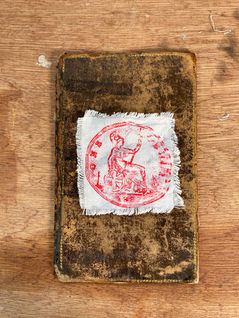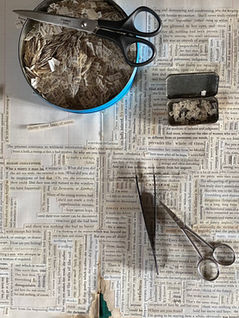
The Artists Prison Residencies programme is run by artists and curators Luminara Florescu and Amanda Lynch in partnership with Shepton Mallet prison in Somerset.
For some of the artists, this will be a “live in” experience as they have requested to be confined to their allocated cells including sleeping overnight. Other artists will be involved in a remote experience as they are confined to their homes through disability. The artists will be spending time in the prison to create work inspired by the building and its history.
The thirteen artists – all women – will be based in the cells of C-wing in the 400-year-old prison.
C-wing was formerly the women’s wing of the prison, and the artists have been inspired by aspects of its history, including the imprisonment of Suffragettes, the prison’s unofficial postal service, the effects of incarceration on women’s health, and the severity of women’s sentences compared to men’s. Each artist has been allocated a cell, where they will be based for their residency.
The residency’s theme of ‘confinement’ has resonance with the current pandemic and the situation of some of the participating artists, who are disabled and have rarely left their homes over the last 18 months because of shielding restrictions. Prison Residencies aims to empower these women to take part in a residency programme at a time when they might otherwise be excluded because of their vulnerable status.
For some of the artists, Prison Residencies will be a ‘live in’ experience including overnight stays in the cells. Others will participate remotely while they are confined to their homes. The programme will provide an opportunity for these women to have their voices heard, and to share the stories of women who have experienced confinement in the past.
Working with a range of artforms, including textiles, film, writing, sculpture, and paper art, the artists will be resident in the old prison building for 16 days. During this time, visitors will be able to talk to the artists and see work in progress.
For her residency, Luminara Florescu will transform one of the cells in C-Wing into a lively research data hub. She is inspired by the daily lives of the prison officers who would have worked in the building; their strict routines, and the objects they would have used, such as their keys. Inspired by the hyper-organised nature of the prison, she will use vintage filing systems to record visitors’ responses and stories relating to the prison. She will invite visitors to test a variety of keys to see if they work in locks she has created.
Co-curator Amanda Lynch will use a blend of digital technologies and Royal Mail post to communicate with other resident artists while she remains at home shielding. She will create collages inspired by former prisoners and their crimes, some of which seem relatively minor by today’s standards. Some collages will be based on information found in historical documents, others will be fictional, representing the many women whose information was not properly recorded.
Resident artists include:
Visual artist Joanne Pudney is a former Police Officer and will use her experiences with women’s imprisonment to explore the way many women lose their identity while in prison. Using folk tales such as Rapunzel, she will explore women’s experience of being in prison.
Janice Wheeler began to lose her sight in 2014, and during lockdown, her guide dog companion died unexpectedly, leading her to feel even more isolated. During her residency, Janice plans to create an interactive artwork with names in Braille. The names will be chosen by visitors to remember people who have been isolated.
Carrie Mason will explore how the prisoners at Shepton Mallet spent their time each day, and how perception of time changes when your time is not in your control. Carrie has been researching the extended sense of the present that is experienced under periods of long restriction. She will make a series of drawings that reflect how time passed for prisoners over a 24-hour period. For example, a drawing of the bed would take the same time to create as the allocated prisoner sleeping time, and the interior of the cell door would be drawn over a period of time representing the amount of time the door is locked.
Polly Hall will explore the theme of communication within the prison environment by covering the ceiling of her cell with white helium-filled balloons. Attached to the balloon tails will be scraps of envelopes with written thoughts and overheard snippets of conversations. The balloons represent speech bubbles, and the colour white was significant for the Suffragettes, some of whom were imprisoned at Shepton Mallet. The artist aims to highlight the contrast between the oppressive history of the building and balloons with their association with joy, childhood and parties.
Deirdre Porter-Hanson will be using the craft skills traditionally associated with women’s work in prison. She will investigate the work that prisoners did, and explore the fabrics associated with prison life, including the use of mattress covers as alternatives to coffins for executed prisoners.
Silvia Carderelli-Gronau is a dance artist, film-maker, and dance movement therapist. She will make a screen-dance film inspired by immersion in the prison space, investigating the qualities of movement that emerge from experiences of isolation, confinement, space restriction and solitude.
Multi-disciplinary artist Emma Rose will be working remotely. She is interested in why women were put in prison and has discovered that theft was a frequent crime. Emma will create an experience in a cell so that it feels like walking into a familiar room. Ordinary items will be displayed, such as bed sheets, simple food and coats – things that were commonly stolen by women in order to survive. Although the objects she will use are not deemed valuable by most people today, their theft in the past would have incurred a lengthy prison sentence.
Fiona Winning will explore feelings and sensations while spending long periods of time within the prison setting. Sharon Gale will embroider words onto a Victorian-style prison apron. Sally Wilkinson will create postcards from thoughts and feelings contributed by the public. Victoria Bone will explore the repetitive patterns of movement made by prisoners; both the enforced routines of prison life and the ritualistic patterns of movement they may have created for themselves in order to gain back some autonomy.
Audio Recording of Project Details here.
Easier Read document
Prison Residencies short film Produced by Jason King
































